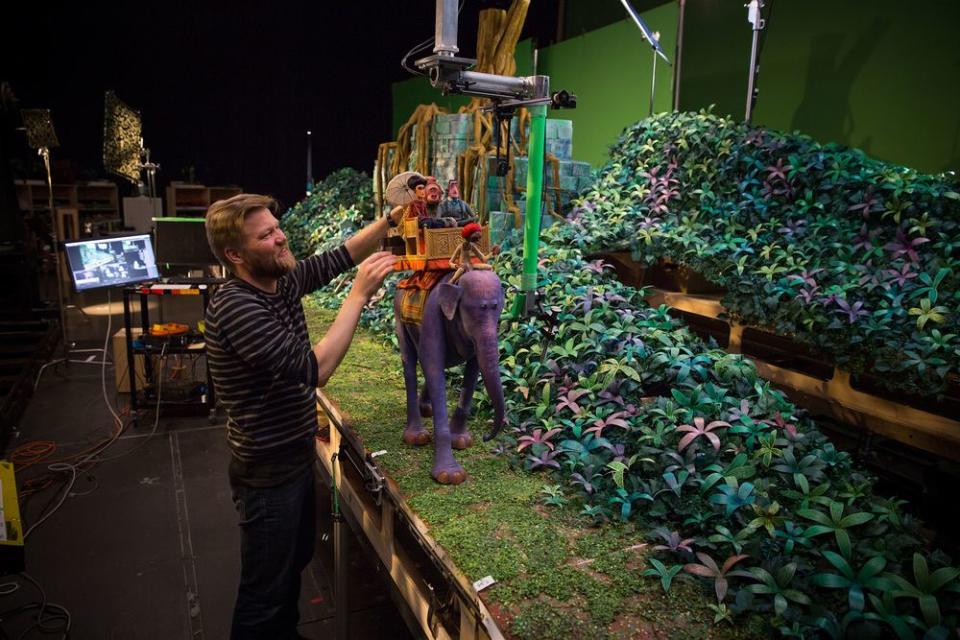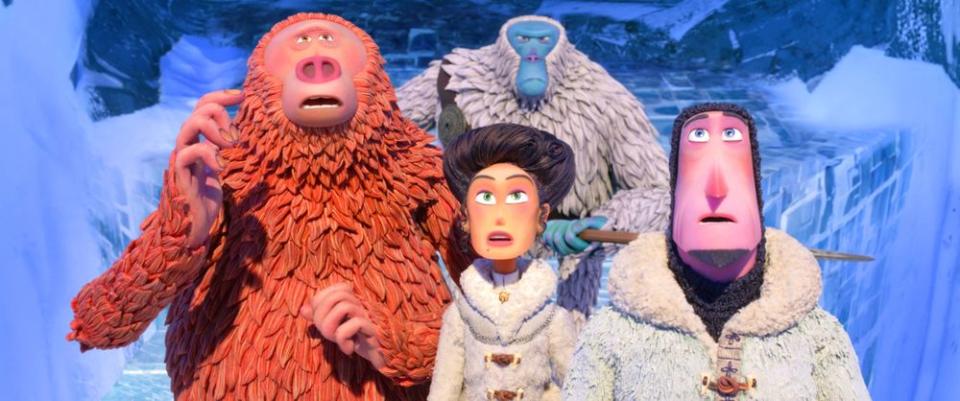With Missing Link, LAIKA's first Golden Globe paves the way for its future

In a landscape that favors sequels, remakes, and the kind of “event” films that often include superheroes or lightsabers, LAIKA remains determined to pursue not just original storytelling, but an art form from the days of classic Hollywood. Stop-motion animation done well feels like a rare occurrence these days, unless your name is Wes Anderson, but it’s been LAIKA’s bread and butter since 2009’s Coraline, which lost the Golden Globe and Oscar to Pixar’s Up. This year feels different for the indie studio. Missing Link, about warm-hearted Sasquatch (Zach Galifianakis) desperately searching for his place in the world, led to LAIKA’s first Golden Globes win after years of being snubbed in favor of Disney titles.
“We’re effectively a band of anal-retentive mole people who are working at a jerkwater town 950 miles away from Hollywood, specializing in an art form that was declared dead a generation ago,” Travis Knight, the head of the Oregon-based LAIKA and a producer on Missing Link, tells EW over the phone one January afternoon. “It’s certainly a questionable recipe for success if I’ve ever heard one.” That’s why awards recognition feels like a welcome sight, one that’s been long-awaited for the house of LAIKA. “As storytellers, the thing that you want more than anything else is to be able to connect with people, to share your stories with the world,” Knight adds. “LAIKA is not some massive multinational, multimedia operation. So, this kind of attention is incredible for us. It raises awareness and interest in our studio and our films. It gets people to maybe give our film a second look, whether they might’ve not known about in the past.”
With this renewed awareness, Knight hopes to keep evolving LAIKA with the times. Much like how the studio fuses the old (stop-motion) with the new (CGI technology), plans are in motion to adapt this craft to the still-changing entertainment landscape. That may include streaming.
“Certainly the film-going experience is changing, the theatrical experience is changing. It’s evolving as it always has,” Knight says. “We find that certain kinds of films tend to perform particularly well in the cinema and others maybe not so much in a way that they did in the past. We’ve also seen an explosion in storytelling across different mediums, including streaming, and so the world is hungrier than ever for stories. We’re content, if you will.”
Knight doesn’t necessarily view this as a detractor, even though LAIKA’s previous films were made to live in the cinema. “When you strip it all down, we’re essentially just storytellers,” he explains. “So, it’s encouraging for us because while we focus on the cinematic experience — and that’s something that we are going to continue to focus our energies on — the opportunity to explore storytelling in different forums and across the mediums and across genres, it’s something that I think we’re incredibly excited about. I think you’ll start to see those types of efforts coming from LAIKA in the days to come.”
Knight confirms there are multiple new films in development, one of which may have already been revealed. The Oregonian newspaper tracked down court documents from 2018 that suggest LAIKA is developing a script about time-traveling Beatles fans. Knight says they are not ready to reveal what’s next after Missing Link, but that all that’s impending “are so different from things that we’ve done in the past, some of them dramatically different which could essentially challenge people’s ideas of what they think a LAIKA movie is.”
What hasn’t changed are what Knight refers to as “humanist stories.” Stories like a young bard’s fantastical encounters with spirits, a talking, monkey, and a warrior beetle, undercut with a boy’s need for family and identity (Kubo). Stories like a kid, orphaned at infancy, who learns that even underground-dwelling creatures can become your family (Boxtrolls). With Missing Link, the story became about connection. The film’s director, Chris Butler, developed the idea after making 2012’s ParaNorman and came up with something a lot lighter than the darker elements of past projects. Visually, that meant something “big, bright, colorful, punchy, but also had a beautiful soul at the core of it.”

“We don’t want a house style,” Knight notes. “We want to really challenge ourselves as visual artists and storytellers.” The studio’s next title, too, pushes them outside their comfort zone to explore new facets of their craft. “These are always humanist stories, films that are about empathy, about connection and explore what it means to be human and hopefully tap into people’s sense of emotion and connection. I will say that this [next] film does that in the same way that the films that we’ve done in the past, but it does so in a very different way.”
Knight thinks back to watching E.T.: The Extra-Terrestrial as a child and experiencing how Steven Spielberg “fundamentally changed” how Knight thought about himself. “It felt like I was seeing a version of myself reflected back to me on the big screen and was deeply moved by that as a young kid,” he says. That’s LAIKA’s aim now, but it comes with obstacles built in. With original stories becoming fewer and fewer far between in the studio film space, pursuing such a path can make it hard to compete against the big titans of animation — Pixar being the biggest of them all — corporations that come with bigger marketing budgets to spread the word and a wider audience.
Animation, no matter the type, already takes a long time. But, “for anyone who knows anything about stop-motion animation,” Knight says, “it’s something that is incredibly glacial in its pace. We craft these movies a frame at a time. We build pretty much everything that you see on screen.”
“If it’s going to take five years from start to finish on one of these movies, what’s the world going to look like in five years?” he adds. “Well, who the hell knows? On some level you have to just follow your gut because you can only do things that are meaningful to you.”
Films like LAIKA’s require such a big investment, not just in terms of resources but time, so Knight is always mitigating the financial risk. The box office returns for the studio seem to dwindle with each new release: ParaNorman made approximately $107.1 million worldwide, The Boxtrolls $108.3 million, Kubo and the Two Strings made $69.9 million, and Missing Link made $26.2 million. “We make our films for a fraction of the budget of some of the big films that you see coming out of the big studios because we have to,” Knight mentions. “It’s a smaller group of people, our threshold for financial success is much lower because we watch our pennies very carefully. We have a much smaller crew who put so much more of their stuff into this, basically, on a person by person basis.”

As the lead animator on ParaNorman, Knight says he single-handedly produced approximately 15 minutes of animation for the film. To put that in perspective, LAIKA’s average animator for that film created 4.38 seconds of film per day, averaging 12.78 seconds per week of production. Burnout is real, but Knight contributes this commitment to the team’s passion for the medium. “Everyone contributes a lot more because we need them to, but also because they’re passionate. You don’t get into this type of work, you don’t get into stop motion specifically because you’re expecting to have a windfall. You get into it because you love it, it’s in your veins, it’s in your bones. It’s such an incredibly passionate group of people at our studio that they pour everything they have into these things. It’s why we’re able to do more with less because we have an extraordinary group of people who love what they do and they live and breathe this stuff.”
That passion will become crucial in the days to come. Oscar winner Guillermo del Toro is working on a stop-motion film based on Pinnochio for Netflix, which picked up another stop-motion feature, Wendell & Wild from Jordan Peele, Keegan-Michael Key, and Henry Selick, the latter of which worked on LAIKA’s Coraline. That makes at least three stop-motion animated films in development in the same time frame. Knight’s strategy to stand out from the crowd of content is the same that it’s always been: “Paradoxically, I have found that the more intimate and more personal you make something, the more universal it becomes. As we’re developing our stories, we always want them to feel different and unique and original, but also you try to find what is the personal, intimate, thematic core at the center of each thing.”
The spotlight reflecting off a golden statuette doesn’t hurt, either.
Related content:
—Animated Missing Link is a wispy-sweet Sasquatch comedy: Review
—Your everything-but-Disney guide to the 2020 Oscars’ Best Animated Film nominees
—Hugh Jackman becomes Big Foot’s buddy in new Missing Link trailer

